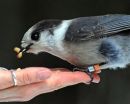(Press-News.org) Researchers at Stanford's Jasper Ridge Biological Preserve often encounter signs of mountain lion activity, from lion scat to the occasional deer carcass covered with leaves. But few have actually caught a glimpse of the shy feline.
Now, images captured by remote wildlife cameras confirm that mountain lions (also called pumas or cougars) make regular visits to Stanford's 1,189-acre preserve in the hills five miles west of the main campus.
Since September 2009, a network of motion-activated infrared cameras has recorded more than 40 photographs and videos of mountain lions in different areas of the preserve. Most of the images were captured between dusk and dawn, occasionally along trails frequented by docents, researchers and staff. However, an analysis of 30 lion photos from summer 2010 suggests that one animal triggered all of the images.
"The cameras are running 24 hours a day," said Trevor Hebert, Jasper Ridge's data manager. "Basically, anything that moves in front of them that's alive will trigger a picture."
The photos suggest a seasonal pattern of lion activity over the last two years, Hebert said, with more visits occurring during the dry months from May to September.
"One of the very encouraging things about all of the mountain lion pictures is that we know that we essentially have an intact ecosystem with the top predator actively killing deer," Hebert said. "We weren't always sure that was the case."
An upsurge in mountain lion photos last spring led the Jasper Ridge advisory committee to recommend a review of preserve policy. In June 2010, Jasper Ridge staff invited a group of Stanford students to serve as academic consultants on the review.
The students were part of the Rising Environmental Leaders Network, a pilot project of Stanford's Woods Institute for the Environment designed to give postdoctoral scholars and graduate students an opportunity to participate in a real-world consulting experience. The project was modeled after the Woods Institute's Leopold Leadership Program. Nicole Ardoin, a member of the Jasper Ridge advisory committee, served as the faculty leader.
"This was a test case – an opportunity to engage faculty, postdocs and graduate students in project-based learning with a risk assessment/management component," said Ardoin, an assistant professor of education and center fellow at the Woods Institute.
The consulting team consisted of five students from different academic disciplines: graduate student Lena Perkins (mechanical engineering) and postdocs Kye Epps (soil science), Steve Litvin (marine ecology), Scott Loarie (landscape ecology) and Mike Papenfus (economics). The students were asked to assess the risk of a human-lion encounter in Jasper Ridge and to explore new opportunities for mountain lion research and conservation in and around the preserve.
In July 2011, after analyzing the photographic data and conferring with experts, the student team submitted its findings and recommendations to the Jasper Ridge advisory council. The report concluded that mountain lions are probably roaming the preserve about 24 percent of the time, but that "there are likely at most only one male, one female and possibly several cubs whose territory includes the preserve."
An adult male lion can weigh 200 pounds and stretch 9 feet from the nose to the tip of the tail. Despite the mountain lions' size and remarkable hunting prowess, humans have little to fear: "Based on historical statewide data, the annual risk of being attacked by a mountain lion in Jasper Ridge is 1 in 10 million," the authors wrote.
"We humans present a greater risk to mountain lions than mountain lions present to us," added Epps, a co-author of the report, which is now available online.
A longer feature on the wildlife camera project at Jasper Ridge will appear in the November issue of Stanford magazine.
INFORMATION:
This article was written by Mark Shwartz, communications/energy writer at the Precourt Institute for Energy.
Related URLs:
Mountain Lion Video
http://www.youtube.com/watch?feature=player_embedded&v=jy-ngOhoNPU
Jasper Ridge Biological Perserve
http://jrbp.stanford.edu
Woods Institute for the Environment
http://woods.stanford.edu
Bay Area Puma Project
http://bapp.org
END
Biological invasions, i.e. the spread of introduced, non-native species, not only serve as ecological model systems, but also bring out the importance of economic activities on ecological processes. Two recent books have shown the extent and variety of the interaction of economics with invasion science and also the variety of approaches to tackling these problems.
Three researchers, lead by Mark Williamson from the University of York, England, argue in the latest issue of the open access journal NeoBiota that the ecological and economic dimensions of the problem of invasive ...
Cities are generally regarded as hostile for wildlife and urbanization a dramatic form of destruction of natural habitats. Still, they are far from dead zones. Their biodiversity may even exceed that of surrounding landscapes, owing to heterogeneous environments and frequent localization in naturally rich areas that historically supplied diverse resources for their human inhabitants.
"This is definitely the case of the city of Prague, Czech Republic", says the lead author Prof. Vojtěch Jarošík of the study published in the open access journal NeoBiota. "Prague contains ...
The company smartphone, the private cellphone, keys for house and car, wallet – the objects we carry around with us every day are becoming more numerous all the time. Which is why many people also use their business smartphone for personal purposes. It may be convenient, but employees and the IT department have different interests: most employees would prefer unlimited use of their smartphones, installing and using whatever programs they like. But this can also open the door to hackers in search of ways of attacking. As a result, IT departments often try to limit the use ...
The farmer casts a worried gaze at his potato field: where only recently a lush green field of plants was growing, much of the foliage has now turned brown – presumably the result of a fungal disease. Usually, by the time the disease becomes visible, it is already too late. The course of the disease is then so advanced that there is little the farmer can do to counteract the damage done. To determine early on whether and how severely his plants are diseased, he would have to submit samples to a laboratory on a regular basis. There, researchers usually employ the ELISA method, ...
It is 7:30 a.m. and high time she left the house; she mustn't be late for her 8 o'clock appointment. But the young lady still feels the need to check that she closed all her windows, because the forecast is for thunderstorms that afternoon. Later, in the car, she realizes that she forgot to check one of the rooms when she went round the house. In situations like this, window contacts can make life easier and give peace of mind. These little electronic helpers are fitted onto window handles, and they can tell from the position of the handle whether the window is wide open, ...
Many of you might know that Congenital Dyserythropoietic Anemia type II (CDA II) is a rare blood disorder, due to a failure in final part of erythropoiesis. What will surprise you is the fact that some mutations responsible for the disease can be tracked 3.000 years back. A study led by the ENERCA member Prof. Achille Iolascon, from CEINGE Advanced Biotechnologies (Naples, Italy) and the University of Naples Federico II, analyzes two mutations (E109K and R14W) of the SEC23B gene and discovers one of them is responsible for the higher frequency of CDA II in Italian population. ...
A new University of Guelph study shows that gray jays hoping to survive and reproduce through Canada's harsh winters need to be able to store food in the right kinds of trees.
The study appears in Oecologia and was co-authored by Prof. Ryan Norris, Department of Integrative Biology; Brian Kielstra, an undergraduate student in the Department of Geography; and Dan Strickland, retired chief naturalist of Algonquin Park in Ontario.
Unlike most birds that migrate for winter, gray jays are year-round residents in the Canadian boreal forest. In winter, they rely on berries, ...
Contrary to the traditional views of the music industry, removal of digital rights management (DRM) restrictions can actually decrease piracy, according to new research from Rice University and Duke University.
Marketing professors Dinah Vernik of Rice and Devavrat Purohit and Preyas Desai of Duke used analytical modeling to examine how piracy is influenced by the presence or absence of DRM restrictions. They found that while these restrictions make piracy more costly and difficult, the restrictions also have a negative impact on legal users who have no intention of ...
Parents of young caffeine consumers take heed: that high-calorie energy drink or soda might present more than just obesity risk. In fact, according to a double-blind, placebo-controlled study that examined responses to stimulants, an individual's subjective response to caffeine may predict how he or she will respond to other stimulant drugs, possibly reflecting differences in risk for abuse of other more serious drugs of abuse, such as amphetamine and cocaine.
The new findings are reported in the November issue of the journal Drug and Alcohol Dependence by Stacey Sigmon, ...
AMHERST, Mass. – Using one of the most sensitive neutrino detectors on the planet, an international team including physicists Laura Cadonati and Andrea Pocar at the University of Massachusetts Amherst are now measuring the flow of solar neutrinos reaching earth more precisely than ever before. The detector probes matter at the most fundamental level and provides a powerful tool for directly observing the sun's composition.
Pocar, Cadonati and colleagues report in the current issue of Physical Review Letters that the Borexino instrument has now measured with high precision ...



